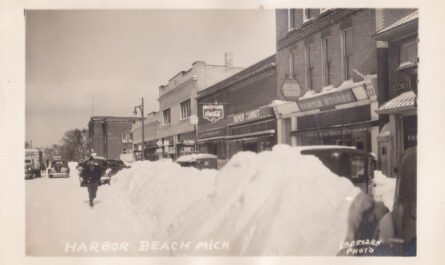Tucked away in Sanilac County in Michigan’s Thumb, the village of Snover offers a window into the rhythms of early 20th-century rural life. These historic images, captured between 1900 and 1910, provide a rare view of a town fueled by agriculture, music, and the slow march of industrial progress. This snapshot of Snover Michigan history enriches our understanding of small-town dynamics during this era.
The town’s namesake, Horace G. Snover, was a notable figure in local politics and business. His influence helped shape this farming community, which, at its height, was a key part of the Thumb region’s economic engine. By the early 1900s, Snover, a vital chapter in Snover Michigan history, was a bustling outpost, with general stores, blacksmiths, churches, and rail connections to larger Michigan cities.
One standout photo features the Snover Cornet Band, assembled proudly on April 1, 1905. Local bands were more than entertainment—they were pillars of community life. Their performances at fairs, parades, and civic events brought residents together, reinforcing a sense of shared identity and purpose.
Snover Michigan History On Main Street
Another photograph captures South Main Street, where hitching posts and wooden awnings frame a street alive with commerce. Wagons line the dirt road, and the faint hum of activity reflects the town’s reliance on farming and local trades. Snover’s businesses were critical lifelines, providing everything from dry goods to farming supplies.
Equally striking is the image of the Detroit, Bay City & Western Railroad in town. Railroads connected Snover to distant markets, allowing local farmers to ship crops and livestock efficiently. The trains also brought in essential goods, news, and visitors, ensuring that even a small town like Snover remained part of a broader economic network.
A photograph of the town’s church, with its tall bell tower and stained-glass windows, reflects the spiritual backbone of the community. Churches were more than places of worship; they hosted socials, charity events, and meetings that helped knit the town together.
Finally, a bird’s-eye view offers a sweeping look at Snover’s layout, surrounded by fields that stretched endlessly toward the horizon. The scene underscores the town’s deep ties to the land and the agricultural lifeblood that sustained it.
These photographs stand as visual records of a time when Snover was growing, striving, and adapting—one field and one family at a time.



